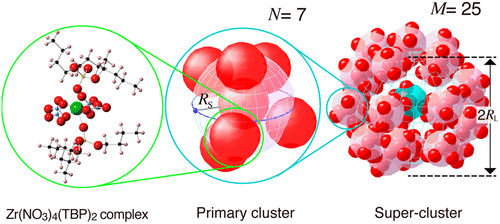当前位置:
X-MOL 学术
›
ACS Cent. Sci.
›
论文详情
Our official English website, www.x-mol.net, welcomes your feedback! (Note: you will need to create a separate account there.)
A Telescoping View of Solute Architectures in a Complex Fluid System
ACS Central Science ( IF 18.2 ) Pub Date : 2018-12-31 00:00:00 , DOI: 10.1021/acscentsci.8b00669 Ryuhei Motokawa 1 , Tohru Kobayashi 1 , Hitoshi Endo 1, 2, 3 , Junju Mu 4 , Christopher D. Williams 4 , Andrew J. Masters 4 , Mark R. Antonio 5 , William T. Heller 6 , Michihiro Nagao 7, 8
ACS Central Science ( IF 18.2 ) Pub Date : 2018-12-31 00:00:00 , DOI: 10.1021/acscentsci.8b00669 Ryuhei Motokawa 1 , Tohru Kobayashi 1 , Hitoshi Endo 1, 2, 3 , Junju Mu 4 , Christopher D. Williams 4 , Andrew J. Masters 4 , Mark R. Antonio 5 , William T. Heller 6 , Michihiro Nagao 7, 8
Affiliation

|
Short- and long-range correlations between solutes in solvents can influence the macroscopic chemistry and physical properties of solutions in ways that are not fully understood. The class of liquids known as complex (structured) fluids—containing multiscale aggregates resulting from weak self-assembly—are especially important in energy-relevant systems employed for a variety of chemical- and biological-based purification, separation, and catalytic processes. In these, solute (mass) transfer across liquid–liquid (water, oil) phase boundaries is the core function. Oftentimes the operational success of phase transfer chemistry is dependent upon the bulk fluid structures for which a common functional motif and an archetype aggregate is the micelle. In particular, there is an emerging consensus that mass transfer and bulk organic phase behaviors—notably the critical phenomenon of phase splitting—are impacted by the effects of micellar-like aggregates in water-in-oil microemulsions. In this study, we elucidate the microscopic structures and mesoscopic architectures of metal-, water-, and acid-loaded organic phases using a combination of X-ray and neutron experimentation as well as density functional theory and molecular dynamics simulations. The key conclusion is that the transfer of metal ions between an aqueous phase and an organic one involves the formation of small mononuclear clusters typical of metal–ligand coordination chemistry, at one extreme, in the organic phase, and their aggregation to multinuclear primary clusters that self-assemble to form even larger superclusters typical of supramolecular chemistry, at the other. Our metrical results add an orthogonal perspective to the energetics-based view of phase splitting in chemical separations known as the micellar model—founded upon the interpretation of small-angle neutron scattering data—with respect to a more general phase-space (gas–liquid) model of soft matter self-assembly and particle growth. The structure hierarchy observed in the aggregation of our quinary (zirconium nitrate–nitric acid–water–tri-n-butyl phosphate–n-octane) system is relevant to understanding solution phase transitions, in general, and the function of engineered fluids with metalloamphiphiles, in particular, for mass transfer applications, such as demixing in separation and synthesis in catalysis science.
中文翻译:

复杂流体系统中溶质体系结构的伸缩视图
溶剂中溶质之间的短时和长时相关性可能会以一种尚未完全了解的方式影响溶液的宏观化学和物理性质。一类称为复杂(结构化)流体的液体-包含由于弱的自组装而导致的多尺度聚集体-在与能源相关的系统中非常重要,该系统用于各种基于化学和生物的纯化,分离和催化过程。在这些中,溶质(质量)跨液-液(水,油)相界转移是核心功能。通常,相转移化学的操作成功取决于整体流体结构,对于这些流体结构,常见的功能基序和原型聚集体是胶束。尤其是,人们已经达成共识,油包水微乳状液中的胶束状聚集体的作用会影响传质和本体有机相的行为,特别是相分离的关键现象。在这项研究中,我们结合X射线和中子实验以及密度泛函理论和分子动力学模拟,阐明了金属,水和酸负载有机相的微观结构和介观结构。关键结论是,金属离子在水相和有机相之间的转移涉及在有机相中一个极端情况下形成的典型的金属-配体配位化学小单核簇,并且它们聚集到多核初级簇中,这些簇自组装形成更大的超分子化学典型的超簇。我们的度量结果相对于更一般的相空间(气-液),在化学分离中基于能学的相分离观点(称为胶束模型)中增加了正交的角度,胶束模型是基于对小角度中子散射数据的解释而建立的。 )软物质自组装和颗粒生长模型。在我们的五聚体中观察到的结构层次(硝酸锆–硝酸–水–三氯甲烷)我们的度量结果相对于更一般的相空间(气-液),在化学分离中基于能学的相分离观点(称为胶束模型)中增加了正交的角度,胶束模型是基于对小角度中子散射数据的解释而建立的。 )软物质自组装和颗粒生长模型。在我们的五聚体中观察到的结构层次(硝酸锆–硝酸–水–三氯甲烷)我们的度量结果相对于更一般的相空间(气-液),在化学分离中基于能学的相分离观点(称为胶束模型)中增加了正交的角度,胶束模型是基于对小角度中子散射数据的解释而建立的。 )软物质自组装和颗粒生长模型。在我们的五聚体中观察到的结构层次(硝酸锆–硝酸–水–三氯甲烷)磷酸正丁酯–正辛烷)系统通常与理解溶液的相变以及具有金属两亲性的工程流体的功能有关,特别是对于传质应用(例如催化科学中的分离和合成中的混合)而言。
更新日期:2018-12-31
中文翻译:

复杂流体系统中溶质体系结构的伸缩视图
溶剂中溶质之间的短时和长时相关性可能会以一种尚未完全了解的方式影响溶液的宏观化学和物理性质。一类称为复杂(结构化)流体的液体-包含由于弱的自组装而导致的多尺度聚集体-在与能源相关的系统中非常重要,该系统用于各种基于化学和生物的纯化,分离和催化过程。在这些中,溶质(质量)跨液-液(水,油)相界转移是核心功能。通常,相转移化学的操作成功取决于整体流体结构,对于这些流体结构,常见的功能基序和原型聚集体是胶束。尤其是,人们已经达成共识,油包水微乳状液中的胶束状聚集体的作用会影响传质和本体有机相的行为,特别是相分离的关键现象。在这项研究中,我们结合X射线和中子实验以及密度泛函理论和分子动力学模拟,阐明了金属,水和酸负载有机相的微观结构和介观结构。关键结论是,金属离子在水相和有机相之间的转移涉及在有机相中一个极端情况下形成的典型的金属-配体配位化学小单核簇,并且它们聚集到多核初级簇中,这些簇自组装形成更大的超分子化学典型的超簇。我们的度量结果相对于更一般的相空间(气-液),在化学分离中基于能学的相分离观点(称为胶束模型)中增加了正交的角度,胶束模型是基于对小角度中子散射数据的解释而建立的。 )软物质自组装和颗粒生长模型。在我们的五聚体中观察到的结构层次(硝酸锆–硝酸–水–三氯甲烷)我们的度量结果相对于更一般的相空间(气-液),在化学分离中基于能学的相分离观点(称为胶束模型)中增加了正交的角度,胶束模型是基于对小角度中子散射数据的解释而建立的。 )软物质自组装和颗粒生长模型。在我们的五聚体中观察到的结构层次(硝酸锆–硝酸–水–三氯甲烷)我们的度量结果相对于更一般的相空间(气-液),在化学分离中基于能学的相分离观点(称为胶束模型)中增加了正交的角度,胶束模型是基于对小角度中子散射数据的解释而建立的。 )软物质自组装和颗粒生长模型。在我们的五聚体中观察到的结构层次(硝酸锆–硝酸–水–三氯甲烷)磷酸正丁酯–正辛烷)系统通常与理解溶液的相变以及具有金属两亲性的工程流体的功能有关,特别是对于传质应用(例如催化科学中的分离和合成中的混合)而言。


























 京公网安备 11010802027423号
京公网安备 11010802027423号